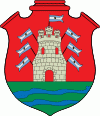Córdoba Province (Córdoba Province)
 |
 |
Córdoba is the second-most populous Argentine province, with 3,308,876 inhabitants, and the fifth by size, at about 165321 sqkm. Almost 41% of its inhabitants reside in the capital city, Córdoba, and its surroundings, making it the second most populous metro area in Argentina.
Before the Spanish conquista the region now called Córdoba Province was inhabited by indigenous groups, most notably the Comechingones and Sanavirones.
Once settled in Alto Perú, the Spaniards searched for a route to the Río de la Plata port in the Atlantic Ocean to transport the Peruvian gold and silver to Europe.
Córdoba de la Nueva Andalucía (nowadays the city of Córdoba) was founded as a middle point on that route on July 6, 1573 by Jerónimo Luis de Cabrera. The Colegio Convictorio de Nuestra Señora de Monserrat was founded by the Jesuits in 1599, followed by the National University of Córdoba, Argentina's first university, in 1613. The city continued to grow as an important cultural center, supported by the trade of precious metals from Peru. In 1761 a printing press was installed in the University.
In 1783, seven years after the consolidation of the Viceroyalty of the Río de la Plata, the Intendency of Córdoba became the capital of what now includes the La Rioja, Mendoza, San Juan, and San Luis Provinces, dividing the former Tucumán Intendency in two. Rafael de Sobremonte was its first governor, when Córdoba City had 38,800 inhabitants.
After the May Revolution in 1810, Governor Juan Gutiérrez de la Concha joined a meeting that decided to ignore the authority of the Buenos Aires Junta. Francisco Ortiz de Ocampo attacked the city and executed the leaders of the opposition, among whom was Santiago de Liniers, leader of the resistance during the British invasions of the Río de la Plata.
Led by Juan Bautista Bustos after 1820, Córdoba struggled for control of the nation with Buenos Aires; the United Provinces of South America had neither legislative nor executive branches at the time. Córdoba sought a federal organization of the provinces while Rivadavia pushed for a centralised government in Buenos Aires. For 15 years, the province was submerged in internal revolts that started to stabilize in 1868 under the provisional government of Félix de la Peña.
During the presidency of Sarmiento an astronomic observatory (1871) and the Faculty of Physical Sciences and Mathematics (1873) were inaugurated.
The creation of the railways and the consequent immigration brought a second wave of population growth to Córdoba. From 1887 on, several agricultural colonies (San Francisco, Marcos Juárez, etc.) emerged, while former rest-point Fraile Muerto (Bell Ville), Ferreira (Villa María) and Los Luceros (Río Segundo), on the route to Buenos Aires, became agricultural, commercial and industrial centers, respectively.
Map - Córdoba Province (Córdoba Province)
Map
Country - Argentina
 |
 |
| Flag of Argentina | |
The earliest recorded human presence in modern-day Argentina dates back to the Paleolithic period. The Inca Empire expanded to the northwest of the country in Pre-Columbian times. The country has its roots in Spanish colonization of the region during the 16th century. Argentina rose as the successor state of the Viceroyalty of the Río de la Plata, a Spanish overseas viceroyalty founded in 1776. The declaration and fight for independence (1810–1818) was followed by an extended civil war that lasted until 1861, culminating in the country's reorganization as a federation. The country thereafter enjoyed relative peace and stability, with several waves of European immigration, mainly Italians and Spaniards, radically reshaping its cultural and demographic outlook; over 60% of the population has full or partial Italian ancestry, and Argentine culture has significant connections to Italian culture.
Currency / Language
| ISO | Currency | Symbol | Significant figures |
|---|---|---|---|
| ARS | Argentine peso | $ | 2 |
| ISO | Language |
|---|---|
| EN | English language |
| FR | French language |
| DE | German language |
| GN | Guarani language |
| IT | Italian language |
| ES | Spanish language |















